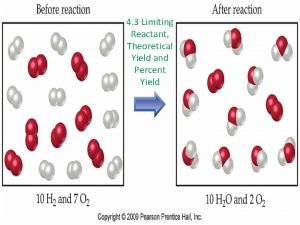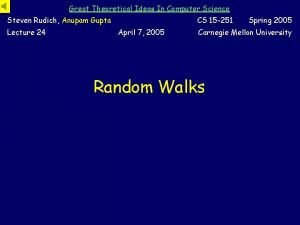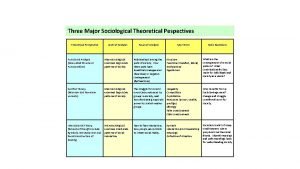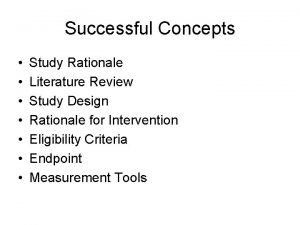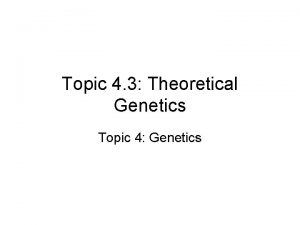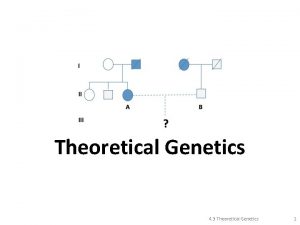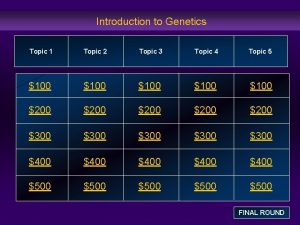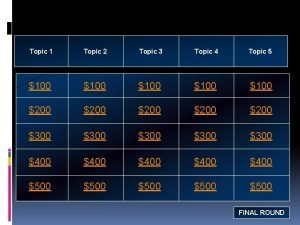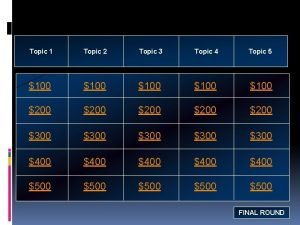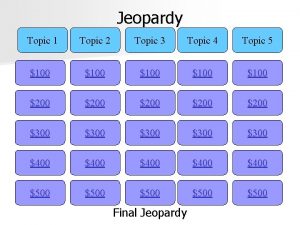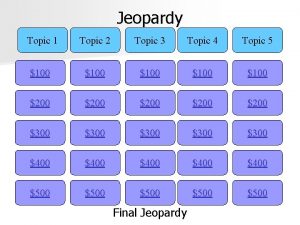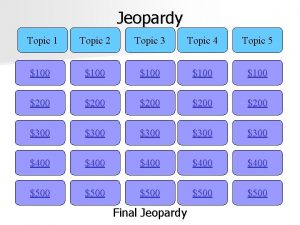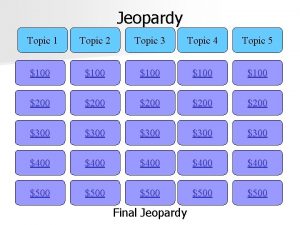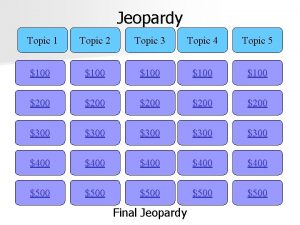Topic 4 Genetics 4 3 Theoretical genetics 1



























- Slides: 27

Topic 4: Genetics 4. 3 Theoretical genetics 1 IB Biology SFP - Mark Polko

ASSESSMENT STATEMENTS 4. 3. 1 Define genotype, phenotype, dominant allele, recessive allele, codominant alleles, locus, homozygous, heterozygous, carrier and test cross. 4. 3. 2 Determine the genotypes and phenotypes of the offspring of a monohybrid cross using a Punnett grid. 4. 3. 3 State that some genes have more than two alleles (multiple alleles). 4. 3. 4 Describe ABO blood groups as an example of codominance and multiple alleles. 4. 3. 5 Explain how the sex chromosomes control gender by referring to the inheritance of X and Y chromosomes in humans. 4. 3. 6 State that some genes are present on the X chromosome and absent from the shorter Y chromosome in humans. 4. 3. 7 Define sex linkage. 4. 3. 8 Describe the inheritance of colour blindness and haemophilia as examples of sex linkage. 4. 3. 9 State that a human female can be homozygous or heterozygous with respect to sex-linked genes. 4. 3. 10 Explain that female carriers are heterozygous for X-linked recessive alleles. 4. 3. 11 Predict the genotypic and phenotypic ratios of offspring of monohybrid crosses involving any of the above patterns of inheritance. 4. 3. 12 Deduce the genotypes and phenotypes of individuals in pedigree charts. IB Biology SFP - Mark Polko 2

4. 3. 1 Define genotype, phenotype, dominant allele, recessive allele, codominant alleles, locus, homozygous, heterozygous, carrier and test cross. Genotype: the alleles of an organism. Phenotype: the characteristics of an organism. Dominant allele: an allele that has the same effect on the phenotype whether it is present in the homozygous or heterozygous state. Recessive allele: an allele that only has an effect on the phenotype when present in the homozygous state. Codominant alleles: pairs of alleles that both affect the phenotype when present in a heterozygote. IB Biology SFP - Mark Polko 3

4. 3. 1 Define genotype, phenotype, dominant allele, recessive allele, codominant alleles, locus, homozygous, heterozygous, carrier and test cross. Locus: the particular position on homologous chromosomes of a gene. Homozygous: having two identical alleles of a gene. Heterozygous: having two different alleles of a gene. Carrier: an individual that has one copy of a recessive allele that causes a genetic disease in individuals that are homozygous for this allele. Test cross: testing a suspected heterozygote by crossing it with a known homozygous recessive. IB Biology SFP - Mark Polko 4

4. 3. 2 Determine the genotypes and phenotypes of the offspring of a monohybrid cross using a Punnett grid. A Punnett grid (or square) is a way of finding the expected ratio of the offspring, given certain parental phenotypes. We can study one of the characteristics Gregor Mendel (1822 -1884) used in his experiments. He studied the size of pea plants and found that ‘tall’ is dominant over ‘short’. If we start with 2 pure breeding (homozygous) plants of contrasting traits (tall and short), we will obtain an F 1 (First filial generation) which has the dominant phenotype (tall) but is heterozygous. When self-fertilising the F 1, we will obtain an F 2 (Second filial generation) which will appear 3/4 dominant (tall) and 1/4 recessive (short). LINK IB Biology SFP - Mark Polko 5

4. 3. 2 Determine the genotypes and phenotypes of the offspring of a monohybrid cross using a Punnett grid. How to solve a problem: (Cambridge, Biology for the IB diploma) • Choose a letter to represent the gene. Choose one that has a distinctly different upper and lower case for the alleles – so for example O, P and W would not be good choices. It is useful to base the letter on the dominant phenotype – so for example R = red could be used for petal colour. • Represent the genotype of each parent with a pair of letters. Use a single letter surrounded by a circle to represent the genotype of each gamete. • Combine pairs of the letters representing the gametes to give all the possible genotypes of the offspring. A Punnett grid provides a clear way of doing this. • From the possible genotypes, work out the possible phenotypes of the offspring. IB Biology SFP - Mark Polko 6

4. 3. 2 Determine the genotypes and phenotypes of the offspring of a monohybrid cross using a Punnett grid. Worked example 1 Suppose that fur colour in mice is determined by a single gene. Brown fur is dominant to white. A mouse homozygous for brown fur was crossed with a white mouse. Determine the possible genotypes and phenotypes of the offspring. Step 1 Choose a letter. Brown is dominant so let B = brown fur and b = white fur. Step 2 We are told the brown mouse is homozygous so its genotype must be BB. Since white is recessive, the genotype of the white mouse can only be bb. If a B were present, the mouse would have brown fur. Step 3 Set out the diagram. Step 4 The Punnett grid shows that all the offspring will be phenotypically brown and their genotype will be Bb. IB Biology SFP - Mark Polko 7

4. 3. 2 Determine the genotypes and phenotypes of the offspring of a monohybrid cross using a Punnett grid. Now lets do this one: A homozygous tall pea plant is crossed with a homozygous short plant. a) What is the geno and phenotype of the offspring? Clearly, as the parent plants are homozygous and one tall and the other short the genotype must be Parent genotypes: TT x tt Parent phenotypes: Tall x Short Gametes: T t Punnett grid F 1: t T Tt Tall All offspring would be heterozygous and tall IB Biology SFP - Mark Polko 8

4. 3. 2 Determine the genotypes and phenotypes of the offspring of a monohybrid cross using a Punnett grid. b) What is the geno and phenotype of the F 2? Clearly, as the parent plants are heterozygous their genotype must be Tt. Parent genotypes: Tt x Tt Parent phenotypes: Tall x Tall Gametes: T and t Punnett grid F 1: T t T TT Tall Tt Tall tt Short IB Biology SFP - Mark Polko 9

4. 3. 3 State that some genes have more than two alleles (multiple alleles). It is possible to have more than two alleles for one gene. A good example of this is found in blood groups. The gene is blood type and the alleles are IA, IB, and i. IB Biology SFP - Mark Polko 10

4. 3. 4 Describe ABO blood groups as an example of codominance and multiple alleles. The ABO blood group system is based on 4 different phenotypes (group A, B, AB and O) caused by different combinations of 3 different alleles (IA, IB and i). The alleles IA and IB are codominant so both will affect the phenotype. The allele i is recessive and will only affect the phenotype when homozygous. IB Biology SFP - Mark Polko 11

4. 3. 4 Describe ABO blood groups as an example of codominance and multiple alleles. Using a Punnett square, it can be worked out how a female with blood group A (heterozygous) and a male with blood group B (heterozygous) can have four children, each with a different blood group. Clearly, as the parent are heterozygous their genotype must be the following. Female Male Parent genotypes: IA i x IB i Parent phenotypes: Blood group A Blood group B Gametes: IA and i IB and i Punnett grid F 1: IB I IA IA IB AB IA i A I IB i B ii 0 IB Biology SFP - Mark Polko 12

4. 3. 4 Describe ABO blood groups as an example of codominance and multiple alleles. There apart from blood groups more examples of codominance. Hair shape in humans is a codominant characteristic. Straight hair and curly hair are codominant alleles and the heterozygote has wavy hair. Pepe and Pepita both have wavy hair. Deduce the probabilities that their children will have straight hair, curly hair or wavy hair. Clearly, as the parent are heterozygous their genotype must be the following. Parent genotypes: Female Hs Hc Male Hs Hc Parent phenotypes: Wavy hair Gametes: Punnett grid F 1: Hs and Hc x Hs Hc Hs Hs Hs Straight Hs Hc Wavy Hc Hc Curly IB Biology SFP - Mark Polko 13

4. 3. 5 Explain how the sex chromosomes control gender by referring to the inheritance of X and Y chromosomes in humans. Humans have 46 chromosomes in somatic cells. These cells are diploid, so there are pairs of homologous chromosomes which carry the same genes and look the same in a karyotype. This is indeed the case for chromosome pairs 1 -22. The remaining two chromosomes are the sex chromosomes. Males have one X and one Y (XY) chromosome, while females have two X chromosomes (XX). A Punnett square can be used to predict the chances of the gender of a child. So the gender-determining factors (the X and Y chromosomes) can be treated like any other trait and predictions can be made accordingly. IB Biology SFP - Mark Polko X chromosome is much larger than the Y chromosome. It contains some genes that are not found on the Y chromosome. 14

4. 3. 6 State that some genes are present on the X chromosome and absent from the shorter Y chromosome in humans. The X chromosome is relatively large; the Y chromosome is much smaller. Several genes are located on the X chromosome such as the ability to see colours and haemophilia but are absent from the Y chromosome. These genes are said to be ‘X -linked’. This means that a male with one allele for colour blindness on the X chromosome, will be colour blind since there is no locus on the Y chromosome. The same applies for haemophilia. Both of these conditions are therefore found much more commonly in males than in females. Only a few genes are located exclusively on the Y chromosome (e. g. hairy ears). IB Biology SFP - Mark Polko 15

4. 3. 7 Define sex linkage. Conditions like colour blindness and haemophilia are much more common in men than in women and are said to be sex-linked. Sex linkage occurs when the genes carried on the sex chromosomes, most often on the X chromosome. LINK IB Biology SFP - Mark Polko 16

4. 3. 8 Describe the inheritance of colour blindness and haemophilia as examples of sex linkage. Colour blindness is a condition that can be caused by genetic factors. Human eyes contain cells with different pigments that absorb different wavelengths (colours) of light. If this pigment absorbs light, a message is sent to the brain and we see a colour. The ability to produce the different pigments is mainly found as genes on the X chromosome. The ability to make the pigment is a dominant allele; the recessive allele will not allow the pigment to be made. A female has two X chromosomes. In order for a female to be colour blind, she would have to have two copies of the recessive allele. A male has only one X chromosome so will only have one copy of the gene. If this is the recessive allele, then the man is colour blind. Existing alleles XB for normal vision, Xb for colour blindness A female can be XB XB or XB Xb or Xb Xb normal vision colour blind A male can be XB Y or Xb Y (genotypes) normal vision colour blind (phenotypes) IB Biology SFP - Mark Polko 17

4. 3. 8 Describe the inheritance of colour blindness and haemophilia as examples of sex linkage. Haemophilia is a blood disorder. Normally, there is a very fine balance for blood clotting. Blood should not clot when it is inside blood vessels or it will block the vessels (possibly causing a stroke) but it should clot when there is injury so that not too much blood is lost. LINK The process of blood clotting involves a number of different proteins, each having their own gene. If even one of these genes has an allele that does not code for the proper protein, the entire process of blood clotting can be disturbed and even very small wounds will not clot. In humans the locus for the gene that controls the production of a blood clotting factor is on the X chromosome (i. e. and not on the Y chromosome). This means that if a male has one defective allele he will have the haemophilia condition. However a female will need to have two copies of the defective allele in order to have the condition. Statistically this is much less likely and with the advent of menstruation and child birth, a woman will need blood transfusions containing the clotting factors to survive. Prior to this technique haemophilia was thought to be homozygous lethal in all cases and some examples in some books are still based on this information. IB Biology SFP - Mark Polko 18

4. 3. 8 Describe the inheritance of colour blindness and haemophilia as examples of sex linkage. Existing alleles XH for normal, Xh for hemophilia. A female can be XH XH or XH Xh or Xh Xh (genotype) normal or carrier hemophiliac, very rare (phenotype) A male can be XH Y or Xh Y (genotype) normal hemophiliac, rare (phenotype) LINK IB Biology SFP - Mark Polko 19

4. 3. 9 State that a human female can be homozygous or heterozygous with respect to sex-linked genes. Sex-linked genes are found on the X chromosome. Since females have two X chromosomes, they can have two dominant alleles (homozygous dominant), two recessive alleles (homozygous recessive) or one dominant and one recessive allele (heterozygous). Males only have one X chromosome. This means that the terms homozygous or heterozygous do not apply. IB Biology SFP - Mark Polko 20

4. 3. 10 Explain that female carriers are heterozygous for X-linked recessive alleles. In humans the locus for the gene that controls the production of a blood clotting factor is on the X chromosome (i. e. and not on the Y chromosome). This means that if a male has one defective allele he will have the haemophilia condition. However a female will need to have 2 copies of the defective allele in order to have the condition. Statistically this is much less likely and with the advent of menstruation and child birth a woman will need blood transfusions containing the clotting factors to survive. Women can be carriers for trait. In that case, they are heterozygous and will not show the trait but are capable of passing it on. Since men only have one X chromosome, the allele on this chromosome will always be expressed. Men can have the allele for colour blindness and be colour blind or have the allele for normal vision and have normal vision. The same applies for haemophilia. Men cannot have the allele without expressing it so they can never be carriers for X-linked traits. LINK IB Biology SFP - Mark Polko 21

4. 3. 11 Predict the genotypic and phenotypic ratios of offspring of monohybrid crosses involving any of the above patterns of inheritance. The accepted notations for the alleles for this characteristics are: Sickle-cell Hb. A = normal Hb. S = sickle-cell Colour blindness Xb = colour blindness XB = normal vision Heamophilia Xh = haemophilia XH = normal blood clotting Codominance, the main letter should relate to the gene, while the superscript should relate to the allele. Both should be capital letters. e. g. CR = red flowers CW = white flower IB Biology SFP - Mark Polko 22

4. 3. 11 Predict the genotypic and phenotypic ratios of offspring of monohybrid crosses involving any of the above patterns of inheritance. Just a reminder: Mendel’s first law Law of segregation ‘Parental factors (genes) are in pairs and split so that one factor is present in each gamete. ’ Mendel’s second law Principle of independent assortment ‘Any of one pair of characteristics may combine with either one of another pair. ’ (dihybrid inheritance) IB Biology SFP - Mark Polko 23

4. 3. 12 Deduce the genotypes and phenotypes of individuals in pedigree charts. Pedigree charts are often used to record blood lines in royal families. It is very likely that Queen Victoria was a carrier with respect to haemophilia because one of her sons was affected and two of her daughters were carriers. IB Biology SFP - Mark Polko 24

4. 3. 12 Deduce the genotypes and phenotypes of individuals in pedigree charts. The genotype of Queen Victoria must have been XH Xh, while her husband was XHY. Leopold must have received Y from his father and Xh from his mother which caused him to have haemophilia. Alice received XH from her father and Xh from her mother, making her a carrier. The same happened to Alice’s daughter, Alexandra. She subsequently passed on her Xh to her son Alexis, who obviously received his Y chromosome from his father Czar Nicolas II of Russia. Alexis had haemophilia. IB Biology SFP - Mark Polko 25

4. 3. 12 Deduce the genotypes and phenotypes of individuals in pedigree charts. So a pedigree chart has always the following format. A square is male and a circle female. Usually, if there is no legend saying otherwise, the black squares or circles are affected individuals and the white one normal. The line through the symbols means the individual is diseased. Lets have a look at some IB questions. IB Biology SFP - Mark Polko 26

Topic 4: Genetics 4. 3 Theoretical genetics 27 IB Biology SFP - Mark Polko
 Clincher in writing
Clincher in writing /topic/ down
/topic/ down What is the excess reactant
What is the excess reactant Great theoretical ideas in computer science
Great theoretical ideas in computer science Great theoretical ideas in computer science
Great theoretical ideas in computer science Theoretical yield stoichiometry
Theoretical yield stoichiometry Conceptual and theoretical framework
Conceptual and theoretical framework Theoretical framework example
Theoretical framework example Sample of theoretical framework
Sample of theoretical framework Major perspective in sociology
Major perspective in sociology Theoretical probability
Theoretical probability Chromatography uses
Chromatography uses 15 251
15 251 Three major sociological perspectives
Three major sociological perspectives Theoretical probability questions
Theoretical probability questions Flow time analysis
Flow time analysis Theoretical molar mass of butane
Theoretical molar mass of butane Example of theoretical probability
Example of theoretical probability Simple probability examples
Simple probability examples 13-1 experimental and theoretical probability
13-1 experimental and theoretical probability Theoretical framework example
Theoretical framework example Theoretical framework for comparative study
Theoretical framework for comparative study Plate theory chromatography
Plate theory chromatography Theoretical probability
Theoretical probability Grounded theory qualitative research
Grounded theory qualitative research Linguistics vs applied linguistics
Linguistics vs applied linguistics Probability experimental vs theoretical
Probability experimental vs theoretical Literature review rationale
Literature review rationale


